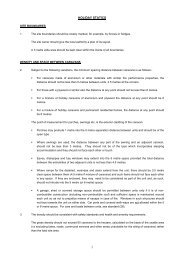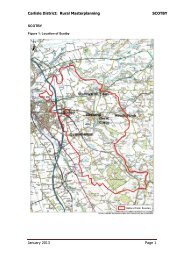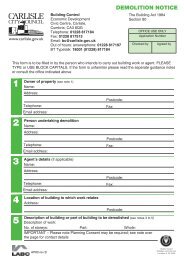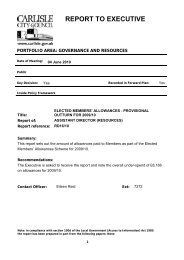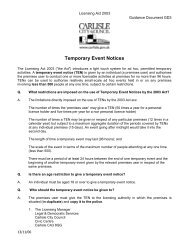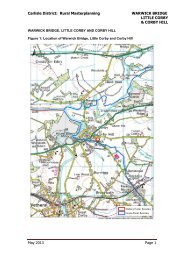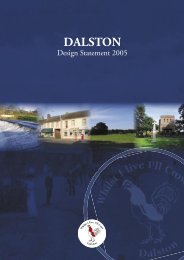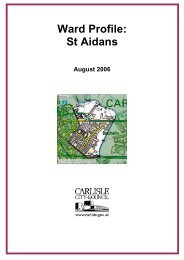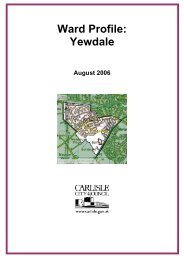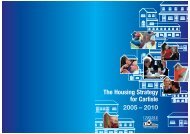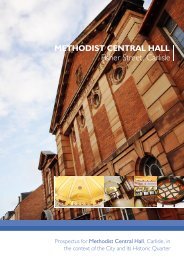Carlisle District Local Plan.indd - Carlisle City Council
Carlisle District Local Plan.indd - Carlisle City Council
Carlisle District Local Plan.indd - Carlisle City Council
Create successful ePaper yourself
Turn your PDF publications into a flip-book with our unique Google optimized e-Paper software.
<strong>Carlisle</strong> <strong>District</strong> <strong>Local</strong> <strong>Plan</strong> 2001 - 2016 Revised Redeposit draftMitigation: Policy also needs to consider effect on cultural heritage. Should define whatredundant land comprises. Some areas perceived as redundant may be high qualityagricultural land/valuable greenfield land (See Policies CP3, LE6-12).4.42 Whilst the preferred location for new development will be in key service centres and localservice centres, changes in agriculture over recent decades have resulted in a declinein farm-related jobs. As a result there is now a need to strengthen the economy in ruralareas. There are often opportunities for reusing or adapting surplus existing rural landand buildings for commercial, industrial, recreational or environmental uses such asguesthouses, farm shops, rural workshops or other small business premises, helping thecountryside to diversify, flourish and sustain itself. The <strong>City</strong> <strong>Council</strong> recognises the importantand changing role of agriculture and the need for new employment in the rural area.4.43 The concept of live/work units provides for small-scale employment uses to help sustain therural economy. They will be viewed favourably as a means of providing employment and/or diversifying existing rural businesses combined with ancillary living accommodation foroccupation, only by those associated with the enterprise either as employees or employeesand their dependants. Proposals will have to ensure that there is no adverse effect on theamenity of adjacent property or the surrounding landscape in line with Core Policies.4.44 The use of surplus rural buildings for the provision of tourist holiday accommodation canhelp to retain the buildings in the countryside whilst helping to boost the rural economy.Conversion of rural buildings to holiday accommodation can, when skilfully undertaken,involve minimal alteration and therefore have little impact on the surrounding countryside.Nevertheless schemes must be sensitive to their environments and measures must be takento mitigate any potential environmental impacts. Developments of this kind must not,however, be seen as a means of providing housing in the rural area and measures willbe taken to ensure that controls are put in place to restrict occupancy on schemes of thisnature.4.45 Traditional, redundant and underused buildings may provide habitats for wildlife such asbats or barn owls. For those species protected by the Wildlife and Countryside Act 1981,the <strong>City</strong> <strong>Council</strong> will seek to ensure a survey is carried out and suitable precautions takenfor the protection of the species and their habitat before permission will be granted. Otherenvironmental diversification schemes may help to improve the ecological value of therural area whilst helping to provide local employment such as schemes to implement theCumbria <strong>Local</strong> Biodiversity Action <strong>Plan</strong>.POLICY EC12 Sustaining Rural Facilities and ServicesOutside the key service centres of Brampton and Longtown, the change of use of alocal shop, public house, post office, doctor’s surgery, dental surgery, school, bank,church/chapel, village hall or other facility considered important to the community willonly be permitted where it can be demonstrated that:1. Its current use is no longer viable and there is currently scope for an alternativecommunity use; and2. There is adequate alternative provision in the locality to serve the localcommunity; and3. All options for their continuance have been fully explored.EC1258 September 2006



